Water supply and sanitation rules: balance calculation + norms of water supply and consumption
Arrangement of communications during the construction or modernization of a house is a rather complicated and responsible process.
Already at the design stage of these two important engineering systems, it is necessary to know and strictly observe the rules of water supply and sanitation in order to avoid future operational problems and conflicts with environmental services.
In our material, we will try to deal with these rules that are not simple at first glance, and tell our readers why they need a water meter and how to correctly calculate the volume of water consumption.
The content of the article:
- Scope of the normative document
- Rules for drawing up the water balance
- Installation requirements for water meters
- Examples of calculating water consumption and sanitation
- Rationing is the basic rule of any calculation.
- The relationship of water consumers and service providers
- Conclusions and useful video on the topic
Scope of the normative document
“Rules for cold water supply and sanitation” - this is the full name of the document approved on July 29, 2013 as N 644. Last revised - April 2018, amendments and additions are valid from April 12, 2018.
The rules determine the relations of subscribers (consumers of services) and organizations supplying them, based on the conclusion of binding agreements.
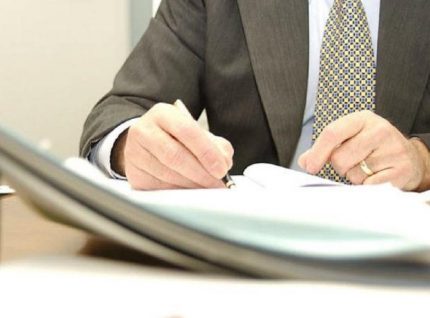
The document also addresses:
- service consumers - individuals, budget organizations, enterprises, etc .;
- the algorithm for connecting objects to the CA (central systems);
- metering of released water, metering of waste water, quality control;
- consumers who are obliged to take into account the discharge of effluents to the central heating with measuring instruments;
- calculation of compensation for the discharge of excessively polluted effluents, the procedure for informing about changes in their composition and properties (filing declarations);
- standards, a mechanism for monitoring their use in practice, determining the size of the excess board;
It should be thought out and provided, and if necessary, created access to plumbing and sewer communications of the subscriber, to the points of water and sewage sampling.
Rules for drawing up the water balance
The calculation of the ratio of water consumption and wastewater is made for each object individually with an assessment of its specificity.
The purpose of the building or premises, the number of future users, the minimum (maximum) estimated water consumption for household or industrial needs are taken into account. All water is taken into account - drinking, technical, its reuse, waste water, storm discharge into the sewers.
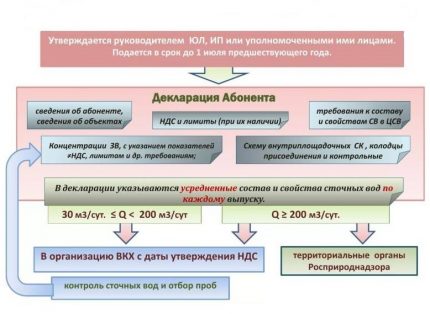
Goals and objectives solved by the balance sheet:
- Obtaining permission for water consumption and water disposal when connected to a centralized system;
- The choice of water and sewer pipes of optimal diameter;
- Calculation of other parameters - for example, power submersible pump, when it comes to the use in private home ownership of the well;
- Obtaining a license for the right to use natural resources (relevant again for the above example - your own independent source of water);
- Conclusion of second-order contracts - let's say you rent an area in an office center, the owner of the building is the subscriber of the water supply channel, and all tenants receive water from his (the owner's) water supply and discharge sewage into his sewer. Therefore, you must pay the owner of the building.
The water balance is a table that shows the ratio of water used and waste water for the year.
There is no single form of a table approved at the federal level, but the initiative is not prohibited, and water utilities offer their own filling samples for customers.
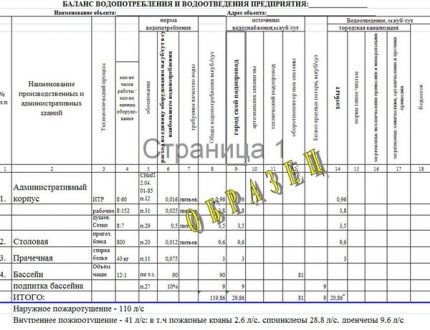
In general terms, drawing up a water balance for a small enterprise will look like this:
- Step 1. We enter consumer groups in the first three columns with numbering, name and quantitative characteristic.
- Step 2 We are looking for standards for each group for water consumption, using internal technical regulations (for the operation of bathrooms and showers), certificates (from the personnel department about the number of employees, from the dining room about the number of dishes, from the laundry about washing volumes), SNiP 2.04.01-85 - “ Internal water supply and sewerage of buildings. ”
- Step 3 We calculate the total water consumption (cubic meters / day), determine the sources of water supply.
- Step 4 We enter the data on water disposal, noting separately the irretrievable losses (watering the lawns, pool water, etc. that does not go into the sewer).
As a result, the justified difference between water disposal and water consumption can be 10-20%. A value of up to 5% is neglected, as a rule, and it is believed that the discharge into the sewer is 100%.
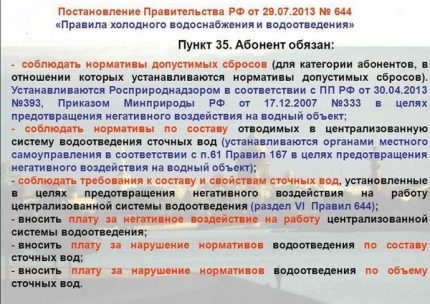
Installation requirements for water meters
Accurately calculated water balance - a significant argument in the rationale water usage fees. With it, one can try to challenge the supplier’s overstated average tariffs, which include the cost of water losses due to pipeline accidents, repairs, basement leaks, prove the need to take into account the seasonality factor, etc.
Practice shows, however, that truth is not easy to achieve, and the best way out is installation of a water meter. According to his testimony, the amount of water used is determined to a drop.
If there is a meter, the calculation for water is simplified: indicator taken off the scoreboard multiplied by the price of 1 cubic meter of water. So, counting devices are mounted both pipes with cold and hot water. It is important to monitor the integrity of the seals and periodically (once every several years) check the serviceability.
For sewage systems, counters for drain water are not provided (with the exception of specific industrial enterprises). Their volume is equal to the volume of water consumed.
Household and individual water meters contribute to saving housing costs. The amount of money in the receipt directly depends on the number of cubic meters saved. Mass implementation of water meters also disciplines employees of water utilities. It is now impossible to write off losses from water losses on worn-out water and sewer networks to the consumer.
Water supply rules are supplemented by provisions related to the installation of meters and their commissioning. You can install the device yourself and invite the master to the house for sealing.
There are two requirements for installing a water meter:
- Place a coarse filter in front of the device to protect it from small debris in tap water.
- Use a check valve at the outlet of the meter in order to prevent it from spinning in the opposite direction.
Before purchasing a meter, it is necessary to check its passport data and verify it with the numbers on the case and device details. One must also inquire about verification and make sure you have a mounting kit.
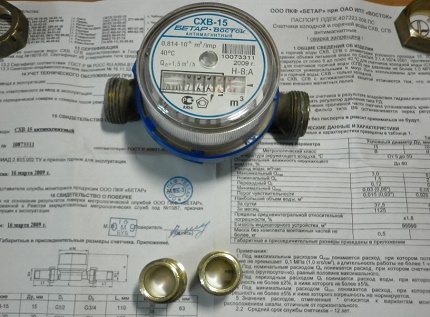
Examples of calculating water consumption and sanitation
The load on the pipelines and devices providing an uninterrupted supply of water to various sanitary equipment (kitchen sink, bathroom tap, toilet bowl, etc.) depends on its flow rate.
In calculating water consumption, the maximum water consumption per day, hour and second (both total and cold and hot separately) is determined. Water disposal has its own calculation method.
Based on the results obtained, the parameters of the water supply system are established according to SNiP 2.04.01-85 - “Internal water supply and sewerage of buildings"[1] and some additional (diameter of the passage of the counter, etc.).
Example 1: volume calculation by formulas
Initial data:
Private cottage with a gas water heater, 4 people live in it. Santekhpribory:
- faucet in the bathroom - 1;
- toilet bowl flushing a tank in the bathroom - 1;
- faucet in the kitchen sink - 1.
It is required to calculate the water flow rate and select the cross section of the supply pipes in the bathroom, bathroom, kitchen, as well as the minimum diameter of the inlet pipe - the one that connects the house to a centralized system or water supply source. Other parameters from the mentioned building codes for a private house are not relevant.
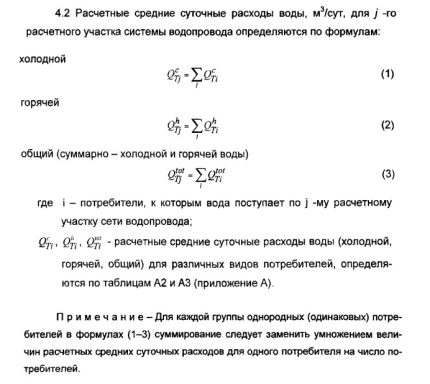
Payment:
1. Water consumption (max) in 1 sec. calculated by the formula:
Qsec = 5 × q × k (l / s)where:
q - water consumption in 1 sec. for one device according to paragraph 3.2 [1]. For a bathroom, a bathroom and a kitchen - 0.25 l / s, 0.1 l / s, 0.12 l / s, respectively (Appendix 2 [1]).
k - coefficient from Appendix 4 [1]. It is determined by the probability of the plumbing (R) and their number (n).
2. Define R:
P = (m × q1) / (q × n × 3600)where
m - people m = 4 people;
q1 - the total maximum rate of water consumption per hour of greatest consumption, q1 = 10.5 l / h (Appendix 3 [1], the presence in the house of a water supply system, bathtub, gas water heater, sewer);
q - water consumption for one device in 1 sec .;
n - the number of units of plumbing, n = 3.
Note: since the value q miscellaneous, then replace q * n summing up the corresponding numbers.
P = (4 × 10.5) / ((0.25 + 0.1 + 0.12) × 3600) = 0.0248
3. Knowing P and n, define k according to table 2 of annex 4 [1]:
k = 0.226 - bathroom, toilet, kitchen (based on n × P, i.e. 1 × 0.0248 = 0.0248)
k = 0.310 - the cottage as a whole (based on n × P, i.e. 3 × 0.0248 = 0.0744)
4. Define Qsec:
bathroom Qsec = 5 × 0.25 × 0.226 = 0.283 l / s
a bathroom Qsec = 5 × 0.1 × 0.226 = 0.113 l / s
kitchen Qsec = 5 × 0.12 × 0.226 = 0.136 l / s
cottage as a whole Qsec = 5 × (0.25 + 0.1 + 0.12) × 0.310 = 0.535 l / s
So, the water consumption is obtained. We now calculate the cross-section (inner diameter) of the pipes by the formula:
D = √ ((4 ×Qsec) / (PI × V)) (m)where:
V - water flow rate, m / s. V = 2.5 m / s according to paragraph 7.6 [1];
Qsec - water consumption in 1 sec., M3/ sec
bathroom D = √ ((4 × 0.283 / 1000) / (3.14 × 2.5)) = 0.012 m or 12 mm
a bathroom D = √ ((4 × 0.113 / 1000) / (3.14 × 2.5)) = 0.0076 m or 7.6 mm
kitchen D = √ ((4 × 0.136 / 1000) / (3.14 × 2.5)) = 0.0083 m or 8.3 mm
cottage as a whole D = √ ((4 × 0.535 / 1000) / (3.14 × 2.5)) = 0.0165 m or 16.5 mm
Thus, a pipe with an internal cross section of at least 12 mm is required for the bathroom, 7.6 mm for the bathroom, and 8.3 mm for the kitchen sink. Minimum diameter of the inlet pipe for supplying 3 plumbing fixtures - 16.5 mm.
Example 2: simplified definition
Those who are scared by the abundance of formulas can make a simpler calculation.
It is believed that the average person consumes 200-250 liters of water per day. Then the daily consumption for a family of 4 people will be 800-1000 liters, and the monthly consumption - 24000-30000 liters (24-30 cubic meters). In private houses in the courtyards there are swimming pools, summer showers, drip irrigation systems, that is, part of the water consumption is irretrievably taken out onto the street.
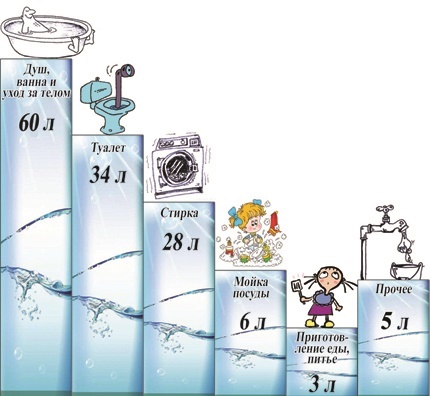
Water consumption is increasing, but there is still a suspicion that the approximate standard of 200-250 liters is unreasonably high. And indeed, after the installation of water meters, the same family, without changing its domestic patterns, winds 12-15 cubic meters on the counter. m, and in economy mode it turns out even less - 8-10 cubic meters. m
The principle of water disposal in a city apartment is this: how much water we consume, we drain as much into the sewer. Therefore, without a counter, they count up to 30 cubic meters. m, and with a counter - no more than 15 cubic meters. m. Since in the private sector not all consumed water goes back to the sewer, it would be fair to use a reduction factor in the calculation of water disposal: 12-15 cubic meters × 0.9 = 10.8-13.5 cubic meters. m
Both examples are conditional, but a table with a real calculation of water consumption and discharge, which can only be done by a qualified engineer, should be available for all business entities (enterprises, housing) that take water for drinking, sanitation, production and discharge drains.
Responsibility for the accuracy of the data used in the calculation lies with the water user.
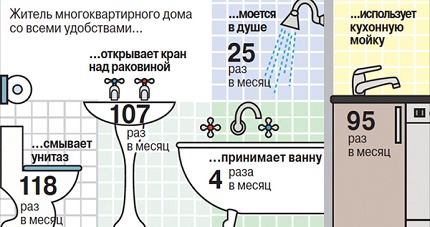
Rationing is the basic rule of any calculation.
Each region has its own norms of water consumption (drinking, for sanitary and hygienic needs, in everyday life and household). This is explained by different geographical location, weather factors.
Let us take the daily norms of volumetric parameters of water consumption and water disposal, distributed to the needs of the household and household. Do not forget that they are the same in the supply and disposal of water, but depend on how well-maintained the dwelling is.
Standard values of water consumption:
- with street standpipe - from 40 to 100 liters per person;
- apartment building without baths – 80/110;
- same with bathtubs and gas heaters – 150/200;
- with centralized cold and hot water supply – 200-250.
For caring for pets, poultry there are also norms of water consumption.They include expenses for cleaning pens, cages and feeders, feeding, etc. 70-100 liters are provided for a cow, 60-70 liters for a horse, 25 liters for a pig, and only 1-2 liters for a chicken, turkey or goose.
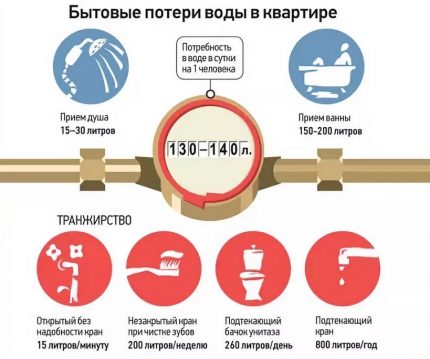
There are norms for the operation of vehicles: tractor equipment - 200-250 liters of water per day, a car - 300-450. It is planned to plan the water consumption for fire fighting for all buildings and structures, regardless of the operational purpose.
Even for gardening societies there is no exception: the rate of water consumption for extinguishing a fire from the outside is 5 liters per second for 3 hours, internal fires from 2 to 2.5.
Water for fire fighting is taken from the water supply. Fire hydrants are placed on water pipes in the wells. If this is not technically feasible or unprofitable, then you will have to take care of the tank with a supply of water. This water must not be diverted for other purposes; the period for restoring stock in the tank is three days.
Irrigation water consumption per day: 5-12 l / m2 for trees, shrubs and other plantings in the open ground, 10-15 l / m2 - in greenhouses and hotbeds, 5-6 l / m2 - for lawn grass and flower beds. In industry, each industry has its own characteristics of rationing water consumption and waste water disposal - water-intensive are pulp and paper production, metallurgy, petrochemicals, food industry.
The main purpose of the regulation is to economically substantiate the norms of water consumption and drainage in order to rationally use the water resource.
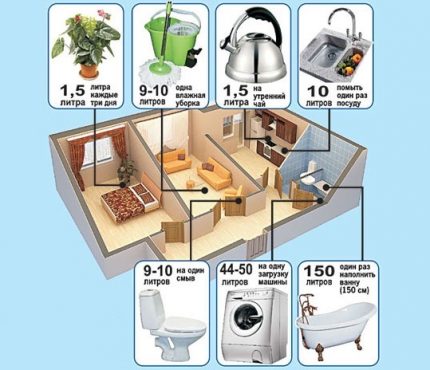
The relationship of water consumers and service providers
Having entered into a contractual relationship with the organization of a water supply and sewer system, you become a consumer of water supply / sanitation services.
Your rights as a user of the provided service:
- require the provider to continuously provide the appropriate service (standard water pressure, safe chemical composition for life and health);
- qualify for the installation of water meters;
- demand recalculation and payment of forfeits in the event that the service is provided in an incomplete volume (the act must be drawn up within 24 hours after the application is submitted);
- terminate the contract unilaterally, but subject to notification of this in 15 days and full payment for the services received;
The subscriber has the right to receive information on payment free of charge (personal account status).
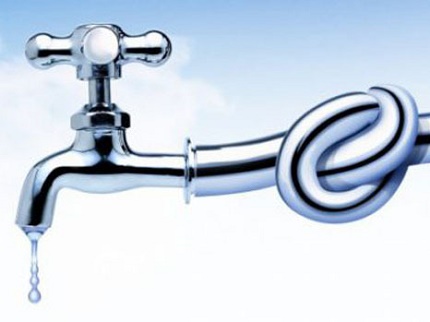
The list of rights of the second party:
- to stop (with prior notification in a few days) the full or partial supply of water and the reception of effluents in case of unsatisfactory technical condition of water supply networks and sewerage;
- require admission to the client’s territory to measure water meters, check seals, and inspect water and sewer systems;
- carry out scheduled preventive repairs on schedule;
- turn off water to debtors for payment;
- stop water supply without warning in case of accidents, natural disasters, power outages.
Disputes and disagreements are resolved through negotiations or in court.
Conclusions and useful video on the topic
How to correctly make the calculation of water consumption:
Water saver. Water consumption reduced by 70:
In order to perfectly understand the intricacies of water supply and drainage from the point of view of the rules, you must be a specialist with a specialized education. But everyone needs general information to understand how much water we get and how much we pay for it.
Saving water consumption and bringing specific consumption to the level of true needs are not mutually exclusive concepts, and this is worth striving for.
If after studying the material you have questions about calculations or water consumption standards, please ask them in the comments. Our experts are always ready to clarify incomprehensible points.

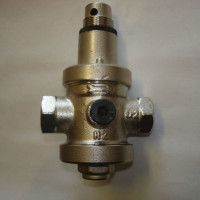 Water pressure reducer in the water supply system: purpose, device, regulation rules
Water pressure reducer in the water supply system: purpose, device, regulation rules 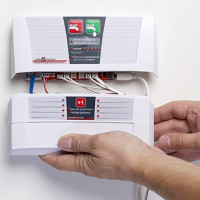 Overview of protection against water leaks “Aquastorozh”: device, advantages and disadvantages, installation rules
Overview of protection against water leaks “Aquastorozh”: device, advantages and disadvantages, installation rules 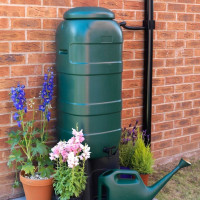 Rainwater harvesting system and options for using rainwater in the house
Rainwater harvesting system and options for using rainwater in the house 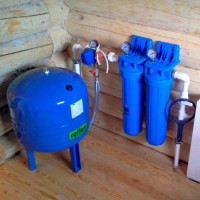 Expansion tank for water supply: selection, design, installation and connection
Expansion tank for water supply: selection, design, installation and connection 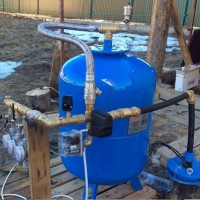 Hydraulic accumulators for water supply: operating principle, types, how to choose the right one
Hydraulic accumulators for water supply: operating principle, types, how to choose the right one 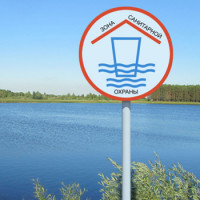 What is a water protection zone + norms for determining its boundaries
What is a water protection zone + norms for determining its boundaries  How much does it cost to connect gas to a private house: the price of organizing gas supply
How much does it cost to connect gas to a private house: the price of organizing gas supply  The best washing machines with dryer: model rating and customer tips
The best washing machines with dryer: model rating and customer tips  What is the color temperature of light and the nuances of choosing the temperature of the lamps to suit your needs
What is the color temperature of light and the nuances of choosing the temperature of the lamps to suit your needs  Replacement of a geyser in an apartment: replacement paperwork + basic norms and requirements
Replacement of a geyser in an apartment: replacement paperwork + basic norms and requirements
Putting a meter, of course, is more profitable than calculating water supply and sanitation according to the norms. The trick is that the volume of wastewater in fact is always greater than that of water supply (we have meters and wastewater at work, we pay to two different organizations for supply and disposal, we also dispose of household waste discharged into the toilet, and waste products) , and pay, it turns out, for the same amount. But here, probably, the premium Kt for the population is included in the tariff.
They installed water meters in the apartment - and immediately they began to pay much less. And we are sure that this is only our expense, and not the posts of the water utility. Counters, of course, were installed by a plumber from a water supplier. It is also a good discipline in terms of saving - you can always see how much water was spent. I control the flow myself constantly, in order to fit into the norms and not overpay.
The norm of water consumption, no matter how, is set by the monopolist Vodokanal. The price per cube of water is set by the scientific method of analogues (“average of neighboring hospitals”). That is, by analogy with neighboring Vodokanals. So it turns out that a cube of cold water supplied by a pump costs as much as a cube of gravity sewage, and hot forty-degree water costs as much as sixty-degree.
I have a counter. Under the project, I was given 2 cubes per day. Actual consumption is not more than 5 cubic meters per day. Vodokanal refuses to renegotiate the contract until I buy more power. The cost of 93,000 rubles per 1 cubic meter. I am ready to buy 3 cubic meters, but ... on the balance of water consumption and sanitation totaled 12 cubic meters per day. And I'm not ready to buy 10 cubes. Not even able to.